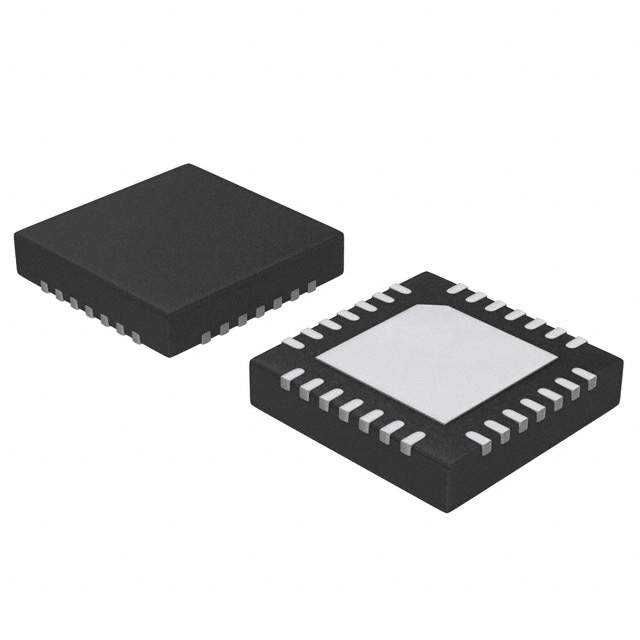Consulte las especificaciones para obtener detalles del producto.

5P49EE805NDGI8
Overview
- Category: Electronic Component
- Use: Clock Generator
- Characteristics: High precision, low jitter, programmable
- Package: QFN (Quad Flat No-leads)
- Essence: Generates clock signals for various electronic devices
- Packaging/Quantity: Tape and Reel, 2500 units per reel
Specifications and Parameters
- Frequency Range: 1 MHz to 200 MHz
- Output Types: LVCMOS, LVDS, HCSL
- Supply Voltage: 2.5V or 3.3V
- Operating Temperature Range: -40°C to +85°C
- Programmable Features: Output frequency, spread spectrum modulation, output format
Pin Configuration
The 5P49EE805NDGI8 has a total of 32 pins. The pin configuration is as follows:
| Pin Number | Pin Name | Function | |------------|----------|----------| | 1 | VDD | Power Supply (2.5V or 3.3V) | | 2 | GND | Ground | | 3 | XIN | Crystal Input | | 4 | XOUT | Crystal Output | | 5 | OE | Output Enable | | 6 | SDA | I2C Serial Data | | 7 | SCL | I2C Serial Clock | | ... | ... | ... | | 32 | VDDO | Output Power Supply |
Functional Characteristics
- Generates high-precision clock signals with low jitter.
- Supports multiple output formats (LVCMOS, LVDS, HCSL).
- Programmable features allow customization of output frequency and spread spectrum modulation.
- Provides output enable control for easy integration into systems.
- Offers I2C interface for configuration and control.
Advantages and Disadvantages
Advantages: - High precision and low jitter ensure accurate timing for electronic devices. - Programmable features allow flexibility in generating clock signals. - Multiple output formats cater to different system requirements. - Output enable control simplifies system integration.
Disadvantages: - Requires external crystal for operation. - Limited frequency range compared to some other clock generators. - I2C interface may require additional circuitry for compatibility.
Applicable Range of Products
The 5P49EE805NDGI8 is suitable for use in various electronic devices that require precise clock signals. It can be found in applications such as:
- Communication equipment
- Networking devices
- Consumer electronics
- Industrial automation systems
- Medical devices
Working Principles
The 5P49EE805NDGI8 utilizes a crystal oscillator as its input source. The crystal generates a stable frequency which is then divided and multiplied to generate the desired output frequency. The programmable features allow customization of the output frequency and modulation options.
Detailed Application Field Plans
Communication Equipment: The 5P49EE805NDGI8 can be used in routers, switches, and modems to provide accurate clock signals for data transmission and synchronization.
Networking Devices: Ethernet switches, network servers, and wireless access points can benefit from the precise clock generation capabilities of the 5P49EE805NDGI8.
Consumer Electronics: Smart TVs, set-top boxes, and gaming consoles often require reliable clock signals for video processing and audio synchronization, making the 5P49EE805NDGI8 a suitable choice.
Industrial Automation Systems: Programmable logic controllers (PLCs), motor drives, and robotic systems rely on accurate timing for synchronized operations, which can be achieved using the 5P49EE805NDGI8.
Medical Devices: Ultrasound machines, patient monitors, and medical imaging equipment require precise clock signals for accurate data acquisition and processing, making the 5P49EE805NDGI8 a valuable component.
Detailed Alternative Models
- 5P49V5901: Similar clock generator with extended frequency range and additional features.
- 5P49V5923: Clock generator with integrated voltage-controlled crystal oscillator (VCXO) for enhanced frequency stability.
- 5P49V5933: Clock generator with multiple independent output banks for different system requirements.
5 Common Technical Questions and Answers
Q: Can I use a different crystal with the 5P49EE805NDGI8? A: Yes, as long as the crystal meets the specified requirements (frequency, load capacitance, etc.), it can be used.
Q: How do I program the output frequency? A: The output frequency can be programmed using the I2C interface and appropriate commands in the device's datasheet.
Q: What is spread spectrum modulation? A: Spread spectrum modulation is a technique used to reduce electromagnetic interference (EMI)

